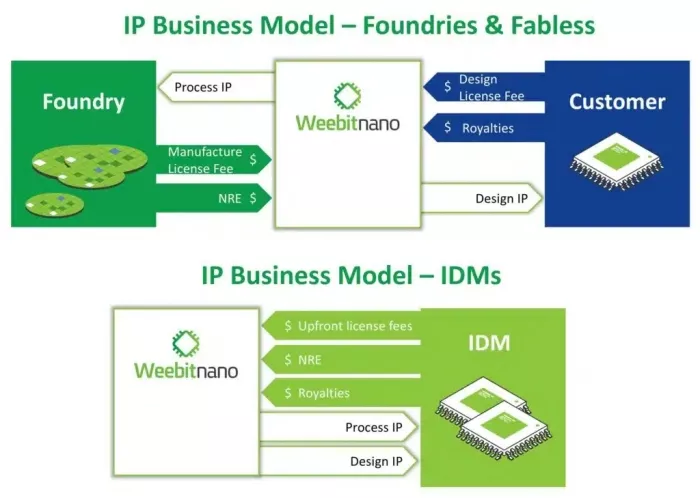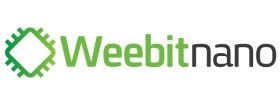Why Weebit’s IP Licensing Model Matters
When people think of semiconductor companies, they often picture vast factories filled with billion-dollar equipment. But Weebit Nano operates in a very different way.
If you’ve read our blog before, then you know that we develop Resistive RAM (ReRAM / RRAM), an advanced non-volatile memory (NVM) technology designed for a new era of AI-powered edge devices, automotive electronics, and other demanding applications. But rather than manufacturing the chips ourselves, we license our technology to companies that integrate it into their own semiconductor products.
This approach is known as semiconductor intellectual property (IP) licensing model, a model that is well established among global semiconductor leaders such as Arm and Ceva. If you don’t know about this model, it’s worth understanding why this model is so compelling.
Asset-light, high-margin, and scalable
Traditional chip manufacturing requires enormous capital investment in fabrication plants (“fabs”) and equipment. Advanced fabs today cost tens of billions of dollars to set up. In contrast, an IP licensing company like Weebit focuses on developing and perfecting its technology. It then licenses it to customers who either have their own manufacturing capabilities or use foundries to outsource manufacturing of their designs.
Weebit provides two types of licenses: manufacturing and design. A manufacturing license gives a fab the right to manufacture devices which include our technology, and a design license allows a product company to embed our technology into their chip.
In the case of a manufacturing license, the customer will also pay a Non-Recurring Engineering (NRE) fee to cover the cost of the technology transfer and qualification. In the case of a design license, the customer might ask for some modifications to the memory module, in which case they will pay NRE fees on top of the design license fees. Once their chips go into mass production, Weebit will receive a royalty payment for every chip sold that uses our technology.

Above: The IP business model can look slightly different, depending on the type of company we are licensing to (e.g., a foundry, IDM, or product company).
Because we don’t need to build factories or maintain inventory, our operating costs are relatively low, and our gross margins can be very high. Looking at comparable IP businesses, such margins can often exceed 90%. This means that once royalty streams begin, revenues can scale quickly without a corresponding rise in expenses.
Long-term, sticky revenues
Another strength of the IP licensing model is its staying power. Once our technology is embedded in a customer’s chip design and manufacturing process, it tends to remain there for the lifetime of that product. For Weebit, that can mean many years of recurring royalty payments from a single design win.
The result is a growing base of long-term, high-margin revenue streams that can compound over time as we add more customers and applications.
Global market opportunity
The global semiconductor market is vast, and with flash memory reaching its scaling limits, there is a growing need for next-generation embedded memory technologies like ReRAM. While some companies develop and use their own ReRAM internally, the majority of the market is open to external licensing. That’s the opportunity Weebit is targeting.
We’ve already signed initial license agreements with major players including DB HiTek (a foundry) and onsemi (an IDM), and we’ve recently signed our license to an end product company in the U.S. We are working towards additional agreements with other such companies across key sectors.
You can read my earlier article, World IP Day: A Time to Reflect on the Value of Semiconductor IP, to learn more about the different types of semiconductor IP and how such solutions are delivered. You can also read more about Weebit’s technology, market position, and licensing strategy in this recent article where Andrew Johnston, Industrial Analyst from MST Access, explores why the IP model is such a powerful driver for our ReRAM ambitions: How Weebit Nano’s IP strategy is fuelling ReRAM ambitions.
Related Semiconductor IP
Related Blogs
- Why Did EDA Have a Hardware Business Model?
- Functional, Fast, and Ultra-Low Power: A Live Look at Weebit's Second IP Module
- World IP Day: A Time to Reflect on the Value of Semiconductor IP
- Why is Hard IP a Better Solution for Embedded FPGA (eFPGA) Technology?
Latest Blogs
- ReRAM in Automotive SoCs: When Every Nanosecond Counts
- AndeSentry – Andes’ Security Platform
- Formally verifying AVX2 rejection sampling for ML-KEM
- Integrating PQC into StrongSwan: ML-KEM integration for IPsec/IKEv2
- Breaking the Bandwidth Barrier: Enabling Celestial AI’s Photonic Fabric™ with Custom ESD IP on TSMC’s 5nm Platform
